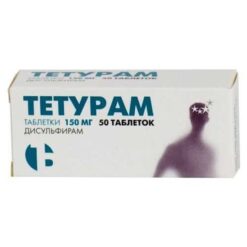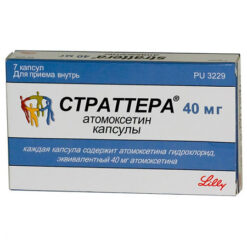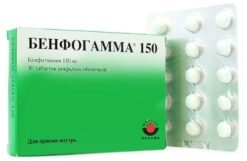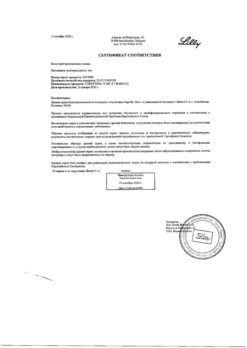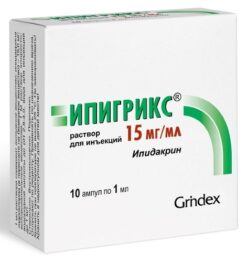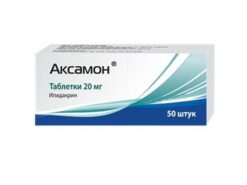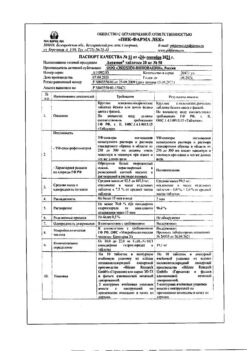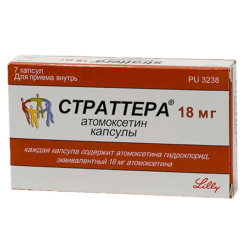No products in the cart.
Teturam, tablets 150 mg 50 pcs
€11.40 €9.98
Out of stock
(E-mail when Stock is available)
EAN: 4601669015204
SKU: 35077
Categories: Medicine, Neurology and Psychiatry, Sedatives and hypnotics
Description
Disulfiram
Indications
Indications
Disulfiram is used as an adjuvant therapy for chronic alcoholism in patients undergoing treatment for alcohol dependence who intend to remain abstinent from alcohol in order to achieve the best effect of supportive and psychotherapy.
Disulfiram does not cure alcoholism. When used as monotherapy, without appropriate motivation and supportive treatment, it does not have a significant effect on alcohol behavior in persons with chronic alcoholism.
Pharmacological effect
Pharmacological effect
Pharmacotherapeutic group: Drug for the treatment of alcoholism
ATC: N07BB01 Disulfiram
Pharmacodynamics:
Disulfiram inhibits the enzyme acetaldehyde dehydrogenase involved in the metabolism of ethanol, which leads to an increase in the concentration of acetaldehyde, which is a metabolite of ethanol, by 5-10 times. Acetaldehyde causes a number of unpleasant sensations: “flushes” of blood to the skin of the face, nausea, vomiting, a feeling of malaise, tachycardia, and a decrease in blood pressure. As a result, a conditioned reflex reaction of disgust to the taste and smell of alcoholic beverages is developed. The strength of the reactions caused by the drug is proportional to the dose taken.
The maximum therapeutic effect is achieved 12 hours after oral administration and can last for 10-14 days after cessation of treatment. The longer the course of therapy, the more pronounced the effects of the drug.
Pharmacokinetics:
Absorption after oral administration is 70-90%. It is rapidly metabolized in the liver by reduction to diethyldithiocarbamate, excreted as a glucuronide by the kidneys, or transformed into diethylamine and carbon disulfide, the proportion of which varies from 4 to 53%. The latter is excreted through the lungs. The minimum content of disulfiram in the blood is about 20 ng/ml.
Special instructions
Special instructions
Under no circumstances should the drug be taken in a state of alcohol intoxication. It is unacceptable to prescribe the drug without notifying the patient. The patient’s relatives should be instructed by the doctor about the specifics of using the drug.
Disulfiram should be used with extreme caution in the following concomitant diseases: diabetes mellitus, hypothyroidism, epilepsy, chronic and acute nephritis, as well as in patients over 65 years of age. Data on hepatotoxicity of the drug, including liver failure requiring liver transplantation or resulting in death, have been reported. Severe and sometimes fatal hepatitis caused by disulfiram therapy may develop many months after drug treatment is completed. The patient must be warned about the need to inform the doctor about all early symptoms of hepatitis, such as fatigue, weakness, malaise, decreased appetite, nausea, vomiting, jaundice, and dark urine. Every 10-14 days from the start of disulfiram therapy, the patient should undergo a control study of liver function parameters, including a general and biochemical blood test.
Patients taking disulfiram should not be exposed to ethylene dibromide or its vapors. Results from studies in rats have demonstrated that inhalation of ethylene dibromide during disulfiram administration increases tumor development and mortality in rats. There are no similar data on the effect of diethyl bromide vapor on patients. Reaction between alcohol and disulfiram:
The patient should be informed of all the consequences of drinking alcohol during treatment with disulfiram.
The patient should be warned about the inadmissibility of secret consumption of alcohol, as well as alcohol in food products (sauces), medicines (alcohol-containing medicines), and perfumes. Drinking alcohol simultaneously with disulfiram, even in small quantities, causes facial flushing, throbbing in the head and neck, throbbing headache, difficulty breathing, nausea, profuse vomiting, sweating, thirst, chest pain, increased heart rate, shortness of breath, decreased blood pressure, weakness, confusion and loss of consciousness, severe anxiety, dizziness, blurred vision. In severe cases, respiratory depression, cardiovascular failure, seizures and death may occur.
The intensity of the reaction varies from person to person, but is usually proportional to the amount of alcohol and disulfiram ingested. Initial manifestations of the reaction can be observed in individuals with hypersensitivity when the alcohol concentration increases to only 5-10 mg in 100 ml of blood. Full development of symptoms occurs at an alcohol concentration of 50 mg per 100 ml. blood. When the blood alcohol level is from 125 mg to 150 mg per 100 ml, loss of consciousness is noted. The duration of the reaction varies from 30 – 60 minutes to several hours; in more severe cases – as long as alcohol is detectable in the blood.
Impact on the ability to drive vehicles. Wed and fur.:
The drug affects the ability to drive vehicles or operate other machinery.
Active ingredient
Active ingredient
Disulfiram
Composition
Composition
Active ingredient: disulfiram – 150 mg.
Excipients: potato starch 2.70 mg, microcrystalline cellulose – 23.80 mg, colloidal silicon dioxide 0.85 mg, croscarmellose sodium 0.85 mg, stearic acid – 0.36 mg, magnesium stearate – 1.44 mg.
Pregnancy
Pregnancy
The use of the drug is contraindicated during pregnancy and breastfeeding.
Contraindications
Contraindications
Hypersensitivity, thyrotoxicosis, diseases of the cardiovascular system (including pronounced cardiosclerosis, atherosclerosis of cerebral vessels, severe myocardial damage, pre- and post-infarction conditions, aortic aneurysm, occlusion of coronary vessels, stage II-III arterial hypertension and other diseases of the cardiovascular system in the decompensation stage), chronic obstructive pulmonary disease, pulmonary tuberculosis with hemoptysis, bronchial asthma, severe pulmonary emphysema, erosive lesions of the mucous membrane of the gastrointestinal tract, peptic ulcer of the stomach and duodenum (in the acute stage), bleeding from the gastrointestinal tract, kidney disease, liver failure, diabetes mellitus, epilepsy, infectious diseases of the central nervous system, polyneuropathy, neuritis of the auditory and ocular nerves, glaucoma, malignant tumors, pregnancy, lactation.
In some cases, with long-term use of Teturam, acute psychoses resembling acute alcoholic paranoid, acute alcoholic hallucinosis or alcoholic delirium may be observed. It is possible for a hallucinatory syndrome to transform into paranoid, paranoid into schizophrenia-like, etc.
Simultaneous (or in the recent past) use of metronidazole, paraldehyde, ethanol or ethanol-containing drugs and products. Children under 18 years of age.
With caution:
Patients over the age of 60 years, peptic ulcer of the stomach and duodenum (in remission), endarteritis, residual effects of cerebrovascular accident, history of psychosis while taking disulfiram.
Side Effects
Side Effects
“Metallic” taste in the mouth, unpleasant odor (caused by carbon disulfide) in patients with colostomy, hepatitis, optic neuritis, peripheral neuritis, polyneuropathy of the lower extremities, neuropsychiatric disorders, memory loss, disorientation in time and space, asthenic syndrome, headache, skin allergic reactions. Side effects caused by the association of disulfiramethanol: collapse, arrhythmia, angina pectoris, myocardial infarction, cerebral edema, cerebral hemorrhage.
Interaction
Interaction
Disulfiram should be prescribed with caution to patients taking phenytoin and its derivatives, since simultaneous use of drugs may lead to phenytoin intoxication. Before prescribing disulfiram, patients taking phenytoin should determine the baseline level of phenytoin in the blood serum and subsequently monitor the level of phenytoin in the blood in order to adjust the dose of the drug.
Disulfiram enhances the effect of indirect anticoagulants and increases the risk of bleeding. In case of simultaneous administration with oral anticoagulants, it is necessary to monitor prothrombin levels more frequently and adjust the doses of anticoagulants. It is also necessary to adjust the dose of disulfiram at the beginning and after the end of the course of therapy, since disulfiram can prolong the prothrombin time.
Effects of disulfiram, incl. neurotoxic, potentiated by tricyclic antidepressants (amitriptyline), metronidazole, isoniazid. Metronidazole increases the risk of developing mental disorders and delirium.
When administered concomitantly with isoniazid, the risk of behavioral disorders and motor coordination increases. If these signs are detected, disulfirs should be discontinued. Disulfiram increases the plasma concentration of drugs metabolized in the liver due to inhibition of microsomal liver enzymes. Enhances the toxic effects of phenazone, chlordiazepoxide and diazepam by inhibiting their metabolism. Ascorbic acid reduces the reaction to ethanol.
Overdose
Overdose
Symptoms: confusion, collapse, coma, neurological complications.
There is no specific treatment for disulfiram overdose. In case of severe disulfiram-alcohol reaction lasting 1.5 hours, oxygen therapy, inhalation of carbogen (a mixture of 95% oxygen and 5% carbon dioxide), high doses of ascorbic acid (up to 1 g), ephedrine sulfate and antihistamines are administered intravenously. Serum potassium concentrations should be monitored, especially if the patient is taking digitalis preparations.
Storage conditions
Storage conditions
Store in a place protected from moisture and light at a temperature not exceeding 25 °C.
Keep out of the reach of children.
Shelf life
Shelf life
4 years. Do not use the drug after the date indicated on the package.
Manufacturer
Manufacturer
Pharmstandard-Leksredstva, Russia
Additional information
| Manufacturer | Pharmstandard-Leksredstva, Russia |
|---|---|
| Medication form | pills |
| Brand | Pharmstandard-Leksredstva |
Other forms…
Related products
Buy Teturam, tablets 150 mg 50 pcs with delivery to USA, UK, Europe and over 120 other countries.


